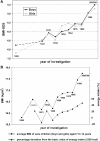Unexpected plateauing of childhood obesity rates in developed countries
- PMID: 24485015
- PMCID: PMC3908468
- DOI: 10.1186/1741-7015-12-17
Unexpected plateauing of childhood obesity rates in developed countries
Abstract
Surveys performed in the past 10 to 15 years show a yet unexplained stabilization or decline in prevalence rates of childhood obesity in developed countries. The projected continuous increase in obesity prevalence throughout future decades seems not to occur at present. Apparently, saturation has been reached, which might be related to societal adjustments. Hence, we postulate a cumulative effect of public health programs for obesity prevention resulting, for example, in an increase in physical activity, and a decline in television viewing and in the consumption of sugar-sweetened soft drinks by children. Effective public health programs are urgently needed for developing countries, where obesity rates in children still continued to increase during the past decade.
Figures

References
Publication types
MeSH terms
LinkOut - more resources
Full Text Sources
Other Literature Sources
Medical
Miscellaneous

